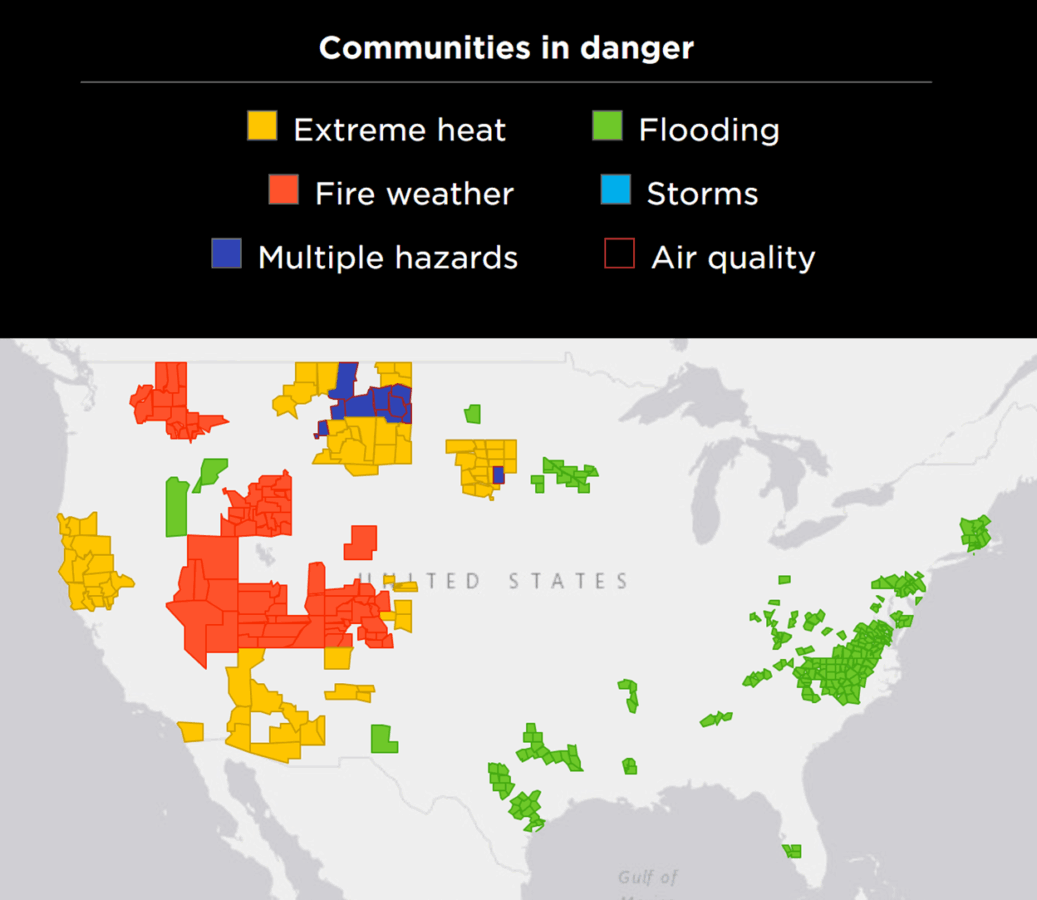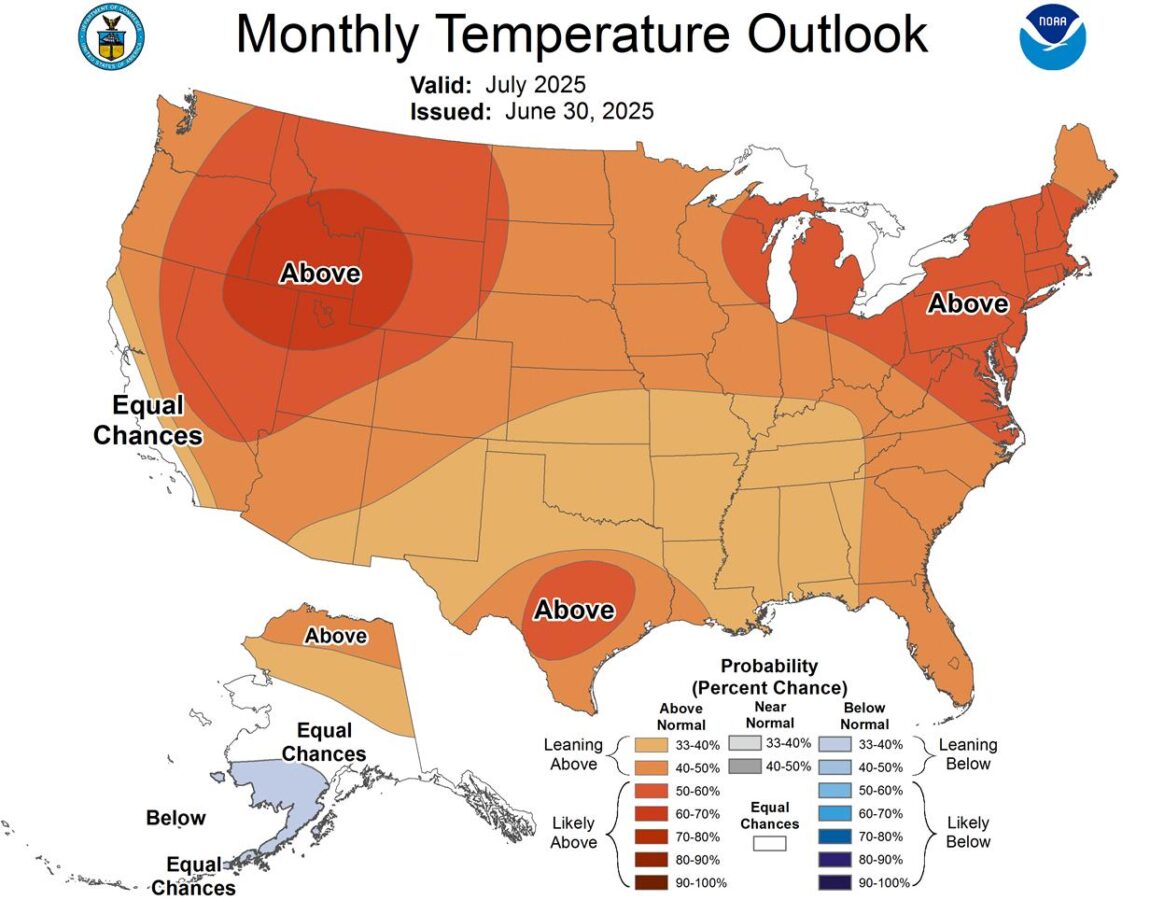Shana Udvardy, Carlos Martínez, and Carly Phillips co-authored this report.
This tumultuous week has had more than its share of terrible news, as well as a few reasons for guarded optimism. In our Danger Season Weekly Outlook we capture some of both and look at the week ahead.
The climate dangers of Danger Season
- All eyes on the Texas flooding: The headline is still the devastation and tragic loss of life in Texas. At this point, more than 120 lives have been lost and 160 people remain missing. Given the Trump Administration’s reckless cuts to NOAA in recent months, there was quick blame cast and lines drawn between those cuts and this tragedy. As our team carefully outlines in the blog we posted, the situation is complex and much is still being learned. But we do want to emphasize our one big takeaway—that we simply cannot allow the Trump administration to continue to attack, defund, and dismantle the very agencies that help keep us safe and recover from disasters, including NOAA and FEMA. Quite the opposite: we need to ramp up investments in cutting-edge science and climate resilience to keep people safer as climate extremes intensify.
- FEMA’s limited response in Texas, which comes as the agency has seen a roughly 1/3 reduction in its permanent workforce to date and faces the President and DHS Secretary Kristi Noem’s threat of total elimination, has been questioned and criticized. Today, as the President heads to Texas, his administration is signaling that they are backing away from the threat of eliminating the agency, but given their rhetoric and the harm done to FEMA to date, we need to stay on high alert in defense of its ability to deliver on its crucial mission—which is, lest anyone forget, to help people before, during, and after disasters. More on this below.
- Wildfire-fueled flooding: In New Mexico, burn scars from last year’s wildfires created a landscape more prone to flash flooding, as the community of Ruidoso just experienced with a historic and deadly flood. Wildfires can create hard, dry land surfaces denuded of vegetation, conditions that, much like drought, prevent rainfall from being absorbed into the ground. With both wildfires and heavy precipitation increasing in frequency and intensity, these dangerous conditions may become more commonplace.

- North America’s fire season heats up – Millions across North America are already feeling the impacts of wildfires, from evacuations to smoke exposure. The largest fires are currently in Alaska and Canada’s western and central provinces, while, as our Danger Season map shows, active fire alerts span large swaths of the western U.S. (shown here in red). And one for the “seriously?” file: A handful of Midwest lawmakers took the unusual step of complaining to Canada about the smoke from its wildfires affecting their states, as if Canada is having a big backyard cookout that it can simply douse and call it a night.

- Looking at the week ahead: NOAA’s Weather Prediction Center is forecasting hazardous heat across large areas of the West and Southeast, and potential heavy rains across the Great Plains, Northeast, and Florida in the coming days. July continues to be a hot month, consistent with NOAA’s forecast of above average temperatures across the entire country. And consistent with our changing climate.

The “Double Danger” of the unchecked Trump administration
It’s enough contending with the climate crisis, but this year of course we have the acute crisis of Trump administration cuts and congressional submission making most matters worse. This week we have been watching:
- The Supreme Court ruling and Trump administration cuts at NOAA and FEMA: SCOTUS allowed the Trump administration to proceed with mass layoffs and agency reorganizations in a ruling earlier this week, although it not did rule on the legality of the firings themselves. A number of groups have filed a legal challenge that will continue to move forward. For now, the ruling unfortunately clears the way for the administration to continue to wreak havoc with further harmful staff cuts at NOAA and FEMA and the further reorganization of those agencies.
- The Neil Jacobs confirmation hearing: President Donald Trump’s nominee to lead NOAA, Dr. Neil Jacobs, appeared before the US Senate Commerce, Science and Transportation Committee on 7/9 for his confirmation hearing. Despite acknowledging and expressing support for NOAA’s critical, life-saving work, Dr. Jacobs’ testimony was at odds with the FY2026 President’s Budget Request, which proposes a 27% cut to NOAA—cuts that Jacobs stated he supports. This comes with scrutiny from his previous run as acting NOAA Administrator where he was willing to undermine science and his employees for political purposes as he did during the infamous ‘Sharpiegate’ scandal. As we have been reporting, NOAA is facing insurmountable cuts to its budget and staffing with more expected. As NOAA administrator, Dr. Jacobs will bear responsibility for standing up to reckless administration staffing and budget cuts that threaten NOAA’s mission.
- More on the dynamic FEMA situation: On Wednesday, the FEMA Review Council, established by President Trump, met for the second time in Louisiana, where Department of Homeland Security Secretary, Kristy Noem, repeated her refrain that FEMA needs to be eliminated as it exists today, that the failures of FEMA are staggering and that states need to take on the role of response and recovery. FEMA has already seen massive cuts to its staffing, programs, and critical budget line items by the Trump administration and Congress and state emergency managers are reporting being “ghosted” by this depleted FEMA in recent months.
- Make no mistake who further FEMA cuts will hurt: vulnerable people and communities. On Wednesday, we hosted a webinar on these topics in which our guest speaker, Jeremy Edwards, former FEMA press secretary, pointed out that in the wake of the terrible flooding, even the relatively well-resourced state of Texas needs federal help (TX requested a disaster declaration which releases robust FEMA support and resources from the federal government); and if Texas needs a strong FEMA, you can bet other, less-resourced states like Mississippi do too.
- So while we welcome the Trump administration’s latest signals that it is backing away from eliminating FEMA, there is much to be done to shore up the agency. The FEMA Review Council may have the appearance of a democratic, public process, but we expect that the recommendations, due before the end of the year, will reflect not those of the council members but the Trump administration’s destructive agenda.
- Deepening federal science brain drain: News broke this week that at least 2,145 senior-ranking NASA employees are departing the agency in response to the administration’s push. These losses hurt the US scientific enterprise in ways that will reverberate for many decades. On our Wednesday webinar, former NOAA Assistant Administrator for Research, Craig McLean, pointed out that the Trump administration-driven loss of NOAA staff to date represents 27,000 years of agency experience. That is an investment our nation made in the vital mission of NOAA, to (1) understand and predict changes in climate, weather, ocean and coasts; (2) share that knowledge and information with others; and (3) conserve and manage coastal and marine ecosystems and resources. With climate change unleashing more deadly extreme events across the country, this mission has never been more critical.
- In better news: Reporting suggests that the Senate Committee on Appropriations is poised to reject the huge FY ’26 funding cuts proposed by the administration to the Departments of Commerce and Justice, as well as other federal science agencies (NOAA, NASA, NIST, NSF, OSTP). The final legislative text from the committee is not yet public, but media reports and statements from committee members are positive. The challenge will be to ensure that the final budget appropriations legislation firmly rejects the destructive Trump administration budget proposal and instead secures robust funding levels as close to the Senate committee numbers as possible. Please join us in demanding that Congress protect the funding and staffing of both NOAA and FEMA.
- Going into next week: we’ll be keeping an eye on the next stages in the appropriations process for NOAA, FEMA, and other scientific agencies, as well as a bill in the Senate to enable the Trump administration’s harmful agenda and claw back money via a so-called recissions package . The outcome of that “rescissions” bill could have broad implications for funding across federal agencies.
Stay the course, and we’ll see you next week.

